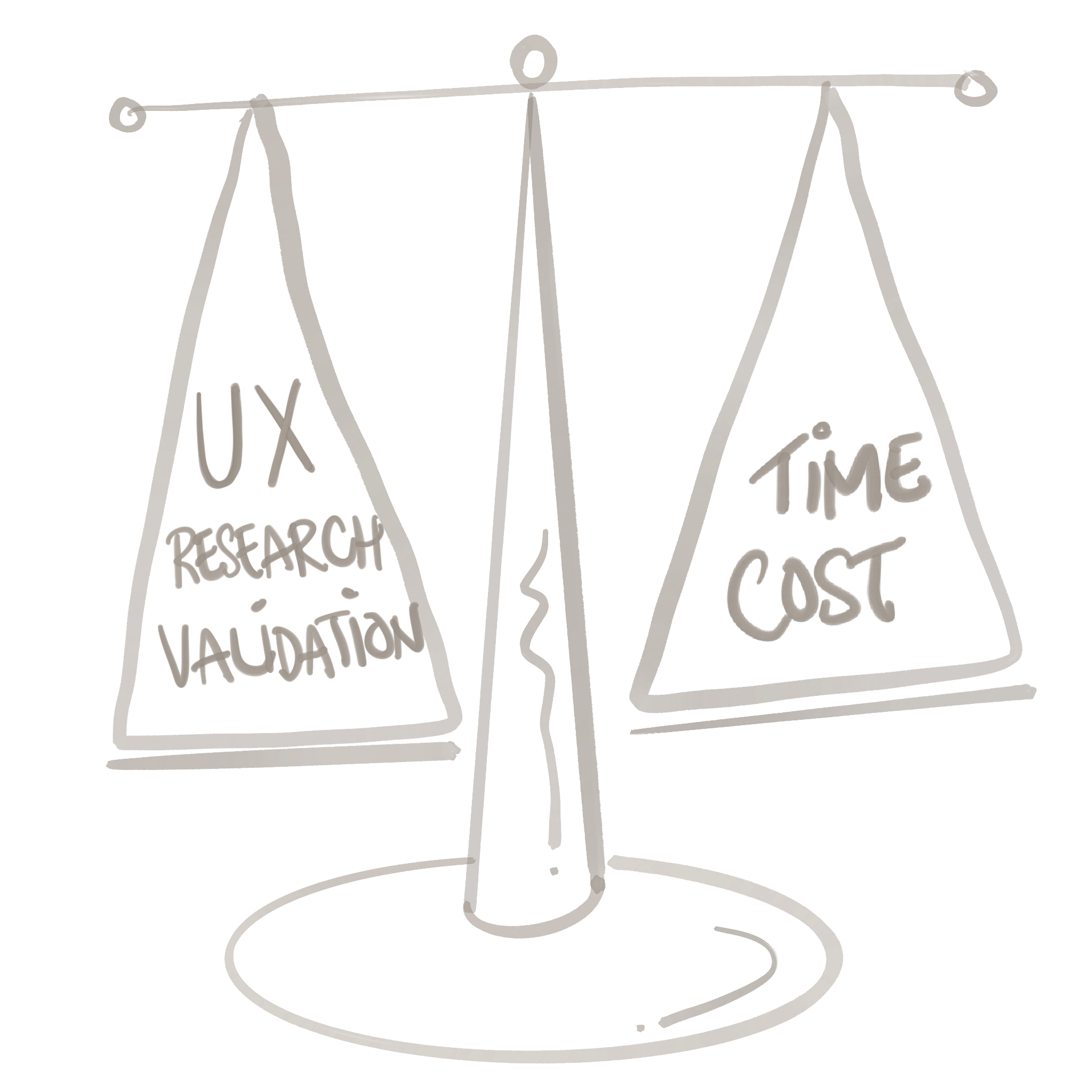Exposing the cost of cutting UX Research & Validation and how to accommodate it successfully.
Unveiling the true price of rushed design – A cautionary tale but one that can be avoided. I am sharing why it's likely not a good idea and some ways to address it as a team.
So, If you are and want to understand other options, read on.
Here is a bit of context around these two capabilities:
UX Research: Understanding the business landscape and customers, their needs, and existing behaviours to formulate the UX strategy or approach. This is a crucial initial step in the early design phase, laying the foundation to align with both business objectives and customer requirements.
UX Validation: Testing to ensure that the design aligns with and fulfils user expectations. This is typically conducted in the later stages of the design phase and before handing over to engineering.
So after a discussion with a peer, I thought it would be an opportunity for me to share and shed some light on the potential impacts of this shortcut and how it may impact your product success in terms of rework down the line or poor results across key metrics. Also, if you read to the end, I will share some practical ways I have partnered with teams to address it.
So let’s kick this off.
As a design leader, I have been part of discussions that look to cut or reduce UX research and/or validation, usually due to deadlines or budgetary pressures, and even because a product leader had a very clear view of what they wanted and that’s what the UX designer needed to design to hand over to the engineers.
In doing so, I have guided teams to work towards accommodating and realising the value of these two capabilities.
I get it… but generally speaking
We are all under pressure and need to do things faster and more efficiently, and cutting UX research and validation is a quick way to save on costs and time and will get your product out the door. However, this can lead to significant problems.
When working with programs and facilitating Retrospectives, a lack of UX research and validation often was a key factor that resulted in outcomes that failed to resonate with customers. I have also seen a correlation where a lack of research increased the discovery and changes post-validation.
That disconnect can be measured and plays out in metrics like high bounce rates, low conversion, and app rankings. If your customers care, you might see it in their verbatims from your app ratings or complaints.
This, coupled with the increased cost associated with fixing issues post-launch, will make you wish we addressed it in the design phase. Also, these changes, sometimes critical in nature, will impact your current delivery schedule and usually bump something from your next release.
My advice is that you really want to get it right the first time for your customers and do the work whilst the hood is up.
A final thought: If you were likely to create Tech debt by cutting something, would you? You should be facing these decisions in the same way, as Experience debt is real.
But it seems like such an easy call at the time. So why wouldn’t I…
So, I understand that UX Research and Validation may seem time-consuming and even costly at first glance of your Epics and User Stories or your project plans for those still using Waterfall. But in my 20 years, I have seen first-hand how this plays out directly and adversely impacts your key metrics and ROI.
Also, people a lot smarter than me, like Forrester, have stated that every dollar you invest in UX brings in between $10 to $100 in return. I am quite confident that we have all seen it regretfully when you go to use something and find it challenging, either because the steps don’t make sense, or there is a lack of clarity on what to do next, or even worse you end up not being able to complete the task at all.
By having good UX practices will reduce friction, forceout and failure of your product leading to it being useful, usable and used.
If you want growth and market share, your product is competing against everyone else's in the market today, and products and their features are becoming very similar, or it could be even worse in that your customers may not see or ever realise their value. We all know that keeping customers in the funnel is important, so when they are, you want to keep them flowing through seamlessly. Yes, you could compete on price, but that is usually just a race to the bottom.
But you can choose that your product will stand out as the easiest, simplest, most efficient and reliable experience that meets your customer’s needs and goals.
Understanding your customers through this form of research and validation enables you to design products that match their expectations and preferences. We have also engaged with excellent experiences that were intuitive, making it easy to use and will or would use it again. You are also more than likely going to tell people about it too. These kinds of experiences translate to uplifts in your key customer and performance metrics for your product, service and organisation.
Here are some other options that you can try, as they have worked for me
So in no particular order, let’s get into them:
When sizing your Epics or User Stories, clearly understand the user or customer impacts and use a scale that correlates to your investment in research and validation. You don’t want to go into it blindly if it is high, so double down and know that not all Epics and User Stories are the same, so adjust accordingly but in consultation. I have realised the best outcomes when having Product, Design, Engineering and Architecture in the session or what I like to call the four-legged stool.
Tip: You need every leg to have a balanced view and assessment.As above, ensure that your Designer is in your Epic and User Story planning sessions. They can help with sizing, but they also might know of similar experiences across your landscape or research already done prior to the session, which can further reduce the investment in research and validation. If you’re an organisation with a mature design function, you may already be operating with a Design System or a library of proven patterns that are known to work and can be reused.
Tip: In my experience reuse will see design efforts shift to innovation.Take a wider view and look for opportunities to consolidate UX research across a couple of Epics or User Stories, if you have access to a customer and you can kill two birds with one stone, it makes sense to do it!
As a product leader, use UX research to validate assumptions, hypotheses, and those things that wake you at 2 a.m. after all these activities are to ensure that both business and customer needs are met in the delivery of the outcome.
As a product leader, don’t go into your Product Roadmap blindly, use UX research to inform, validate and prioritise the release of what comes next. To support this, designers can thematically group insights into themes and then rate them to add value to your understanding of what outcomes your customers want from your product or service. Select from different methods for this from RICE (Reach, Impact, Confidence & Effort), Critical Path (Prioritisation of tasks within a primary flow of your product), Kano (Rate against customer perceived value of the outcome), ROI Scorecard, MoSCoW (Standing for Must have, Should have, Could have, Will not have).
As a product team, see UX Validation as a key milestone, and celebrate it across your team and your wider organisation. It might be the first time that you have had your product in the hands of your customers, it may have validated a Big Bet or even given consideration to a change or pivot in your strategy or approach.
Tip: I have first-hand seen how executives love it when you showcase actually customer feedback, even more so when it is in video format.As a program, REUSE the customer feedback to have a retrospective and health check on your product strategy, approach and quarterly prioritisation and forecasting.
Always invest in the validation of the designs for a few reasons:
- We are only human and come into things with our own biases, not to mention that we are open to mistakes. A customer lens usually will find and correct this.
- The other reason was mentioned before, but a change in Figma (or any design tool) costs far less than when it’s in code or even worse if it’s already been deployed.As designers, we also need to educate how we got to the final design by highlighting what changed because of the value derived from undertaking the research and validation.
- In your Showcases, present and share your findings, connect what was learned and how it is being applied or will inform the approach. Top tip When setting up for the interviews, ensure you let people know that you want to video record the session, as they play out really well and will support reuse and future comms.
- In Design walkthroughs, highlight where things were influenced by these activities, which led to why it was designed this way or what changed.
Tip: People want to see how their investment was realised, I also suggest this is a key reason why as a designer with this knowledge, you should be presenting the work.As designers, if there is not a formal design QA process or forum to present your designs in, seek peer reviews. These are great ways to ensure confidence in what will be handed over to engineering, and especially of value in the event that research or validation challenges have occurred.
As design leaders, there is significant value in the consideration of centralising the research capabilities within your organisation. While there are important factors to consider when moving towards this organisational design, the benefits are considerable. These include the ability to reuse a library of insights, concentrate research efforts on areas of significant impact and closing out gaps, thereby reducing costs across programmes and freeing up designers' capacity. Centralising research can also elevate the overall research capability. The insights repository can offer support to the wider organisation and complement your data and analytics functions. I worked in companies that have used Dovetail for this purpose in the past.
In an environment where our customers understand what good looks like and what represents value for them, and when we are in a time where external factors are making them more conscience of their spending, can you really afford not to ask them what they need and how it will represent value in their lives? As you can see, there are always options to find time to get in front of your customers and understand and validate that you are on the right track and that you are getting it right!
I hope this has highlighted the benefits and some approaches to enable you to prioritise UX research and validation. Making informed decisions and embracing the true value of these processes can pave the way for successful, customer-centric designs. Remember, investing in understanding your customers is an investment in the success and longevity of your product.
Here's to delivering exceptional customer experiences that resonate and endure.
As always, if you need support, guidance or assistance in delivering excellent products that your customers will love, I am here to help.


